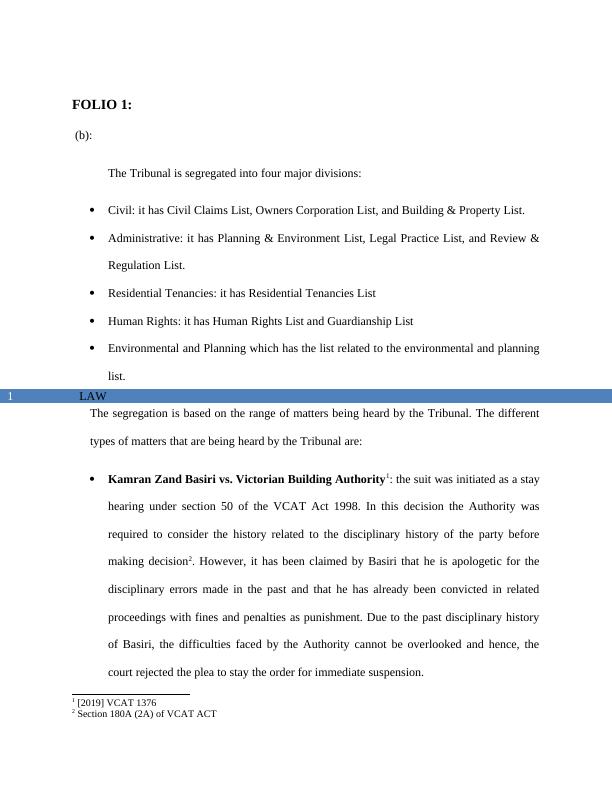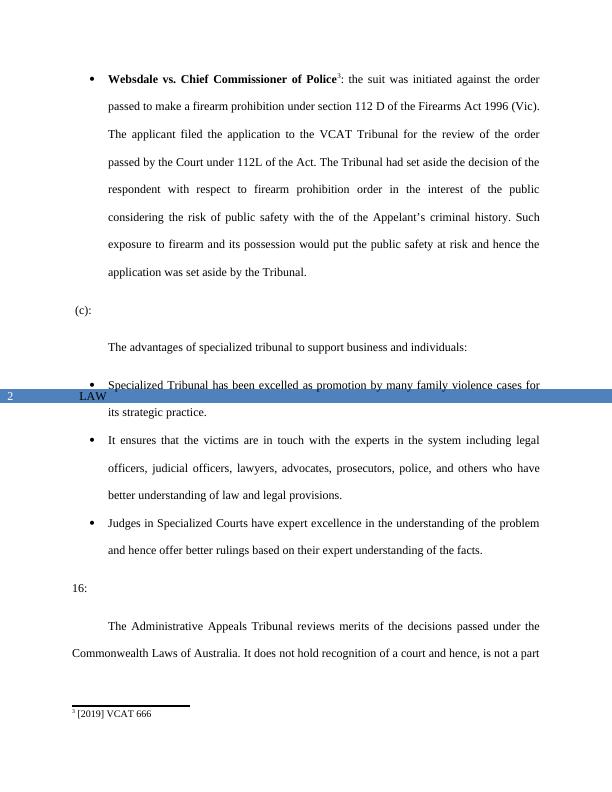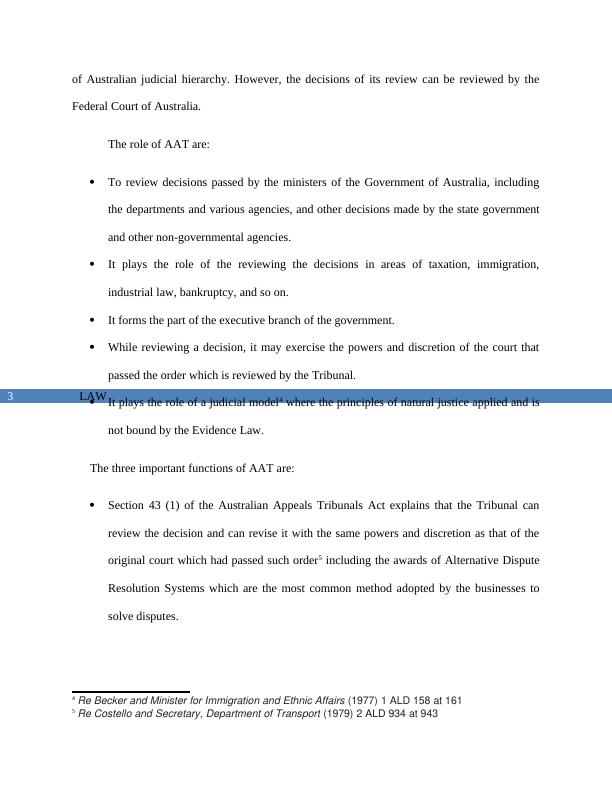The Tribunal of Arbitration (Trial)
Undertake research, accurately reference sources using AGLC4, and submit answers to required tasks in the submission area on Canvas.
14 Pages2832 Words14 Views
Added on 2022-10-10
The Tribunal of Arbitration (Trial)
Undertake research, accurately reference sources using AGLC4, and submit answers to required tasks in the submission area on Canvas.
Added on 2022-10-10
ShareRelated Documents
Running Head: LAW
COMMERCIAL LAW
Name of the student
Name of the University
Author’s Note
COMMERCIAL LAW
Name of the student
Name of the University
Author’s Note

LAW1
FOLIO 1:
(b):
The Tribunal is segregated into four major divisions:
Civil: it has Civil Claims List, Owners Corporation List, and Building & Property List.
Administrative: it has Planning & Environment List, Legal Practice List, and Review &
Regulation List.
Residential Tenancies: it has Residential Tenancies List
Human Rights: it has Human Rights List and Guardianship List
Environmental and Planning which has the list related to the environmental and planning
list.
The segregation is based on the range of matters being heard by the Tribunal. The different
types of matters that are being heard by the Tribunal are:
Kamran Zand Basiri vs. Victorian Building Authority1: the suit was initiated as a stay
hearing under section 50 of the VCAT Act 1998. In this decision the Authority was
required to consider the history related to the disciplinary history of the party before
making decision2. However, it has been claimed by Basiri that he is apologetic for the
disciplinary errors made in the past and that he has already been convicted in related
proceedings with fines and penalties as punishment. Due to the past disciplinary history
of Basiri, the difficulties faced by the Authority cannot be overlooked and hence, the
court rejected the plea to stay the order for immediate suspension.
1 [2019] VCAT 1376
2 Section 180A (2A) of VCAT ACT
FOLIO 1:
(b):
The Tribunal is segregated into four major divisions:
Civil: it has Civil Claims List, Owners Corporation List, and Building & Property List.
Administrative: it has Planning & Environment List, Legal Practice List, and Review &
Regulation List.
Residential Tenancies: it has Residential Tenancies List
Human Rights: it has Human Rights List and Guardianship List
Environmental and Planning which has the list related to the environmental and planning
list.
The segregation is based on the range of matters being heard by the Tribunal. The different
types of matters that are being heard by the Tribunal are:
Kamran Zand Basiri vs. Victorian Building Authority1: the suit was initiated as a stay
hearing under section 50 of the VCAT Act 1998. In this decision the Authority was
required to consider the history related to the disciplinary history of the party before
making decision2. However, it has been claimed by Basiri that he is apologetic for the
disciplinary errors made in the past and that he has already been convicted in related
proceedings with fines and penalties as punishment. Due to the past disciplinary history
of Basiri, the difficulties faced by the Authority cannot be overlooked and hence, the
court rejected the plea to stay the order for immediate suspension.
1 [2019] VCAT 1376
2 Section 180A (2A) of VCAT ACT

LAW2
Websdale vs. Chief Commissioner of Police3: the suit was initiated against the order
passed to make a firearm prohibition under section 112 D of the Firearms Act 1996 (Vic).
The applicant filed the application to the VCAT Tribunal for the review of the order
passed by the Court under 112L of the Act. The Tribunal had set aside the decision of the
respondent with respect to firearm prohibition order in the interest of the public
considering the risk of public safety with the of the Appelant’s criminal history. Such
exposure to firearm and its possession would put the public safety at risk and hence the
application was set aside by the Tribunal.
(c):
The advantages of specialized tribunal to support business and individuals:
Specialized Tribunal has been excelled as promotion by many family violence cases for
its strategic practice.
It ensures that the victims are in touch with the experts in the system including legal
officers, judicial officers, lawyers, advocates, prosecutors, police, and others who have
better understanding of law and legal provisions.
Judges in Specialized Courts have expert excellence in the understanding of the problem
and hence offer better rulings based on their expert understanding of the facts.
16:
The Administrative Appeals Tribunal reviews merits of the decisions passed under the
Commonwealth Laws of Australia. It does not hold recognition of a court and hence, is not a part
3 [2019] VCAT 666
Websdale vs. Chief Commissioner of Police3: the suit was initiated against the order
passed to make a firearm prohibition under section 112 D of the Firearms Act 1996 (Vic).
The applicant filed the application to the VCAT Tribunal for the review of the order
passed by the Court under 112L of the Act. The Tribunal had set aside the decision of the
respondent with respect to firearm prohibition order in the interest of the public
considering the risk of public safety with the of the Appelant’s criminal history. Such
exposure to firearm and its possession would put the public safety at risk and hence the
application was set aside by the Tribunal.
(c):
The advantages of specialized tribunal to support business and individuals:
Specialized Tribunal has been excelled as promotion by many family violence cases for
its strategic practice.
It ensures that the victims are in touch with the experts in the system including legal
officers, judicial officers, lawyers, advocates, prosecutors, police, and others who have
better understanding of law and legal provisions.
Judges in Specialized Courts have expert excellence in the understanding of the problem
and hence offer better rulings based on their expert understanding of the facts.
16:
The Administrative Appeals Tribunal reviews merits of the decisions passed under the
Commonwealth Laws of Australia. It does not hold recognition of a court and hence, is not a part
3 [2019] VCAT 666

LAW3
of Australian judicial hierarchy. However, the decisions of its review can be reviewed by the
Federal Court of Australia.
The role of AAT are:
To review decisions passed by the ministers of the Government of Australia, including
the departments and various agencies, and other decisions made by the state government
and other non-governmental agencies.
It plays the role of the reviewing the decisions in areas of taxation, immigration,
industrial law, bankruptcy, and so on.
It forms the part of the executive branch of the government.
While reviewing a decision, it may exercise the powers and discretion of the court that
passed the order which is reviewed by the Tribunal.
It plays the role of a judicial model4 where the principles of natural justice applied and is
not bound by the Evidence Law.
The three important functions of AAT are:
Section 43 (1) of the Australian Appeals Tribunals Act explains that the Tribunal can
review the decision and can revise it with the same powers and discretion as that of the
original court which had passed such order5 including the awards of Alternative Dispute
Resolution Systems which are the most common method adopted by the businesses to
solve disputes.
4 Re Becker and Minister for Immigration and Ethnic Affairs (1977) 1 ALD 158 at 161
5 Re Costello and Secretary, Department of Transport (1979) 2 ALD 934 at 943
of Australian judicial hierarchy. However, the decisions of its review can be reviewed by the
Federal Court of Australia.
The role of AAT are:
To review decisions passed by the ministers of the Government of Australia, including
the departments and various agencies, and other decisions made by the state government
and other non-governmental agencies.
It plays the role of the reviewing the decisions in areas of taxation, immigration,
industrial law, bankruptcy, and so on.
It forms the part of the executive branch of the government.
While reviewing a decision, it may exercise the powers and discretion of the court that
passed the order which is reviewed by the Tribunal.
It plays the role of a judicial model4 where the principles of natural justice applied and is
not bound by the Evidence Law.
The three important functions of AAT are:
Section 43 (1) of the Australian Appeals Tribunals Act explains that the Tribunal can
review the decision and can revise it with the same powers and discretion as that of the
original court which had passed such order5 including the awards of Alternative Dispute
Resolution Systems which are the most common method adopted by the businesses to
solve disputes.
4 Re Becker and Minister for Immigration and Ethnic Affairs (1977) 1 ALD 158 at 161
5 Re Costello and Secretary, Department of Transport (1979) 2 ALD 934 at 943

End of preview
Want to access all the pages? Upload your documents or become a member.
Related Documents
The Victorian Civil and Administrative Appeals Tribunallg...
|11
|2486
|18
